Not far from Milan Central Station there is Parco Gallery, the first graphic design and visual culture reality dedicated to the experimentation and exploration of communication in its multiple expressions. Founded by Loredana Bontempi (1985, Brescia) and Emanuele Bonetti (1985, Lucca) as an exhibition space and bookshop of Parco Studio, the gallery proposes itself as a place for meeting and discussion capable of building a dynamic dialogue with the neighbourhood and its inhabitants. From the outset, the space has been characterised by a curatorial program rich in international guests and a bias towards social issues such as sustainability, climate change and gender inclusion.
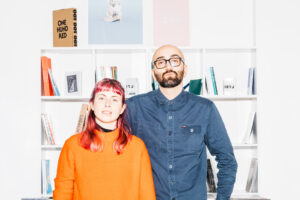
Loredana Bontempi ed Emanuele Bonetti di Parco Studio, © Cartacarbone, courtesy the Parco Studio
Mariavittoria Pirera: How did the idea for Parco Gallery come about?
Loredana Bontempi ed Emanuele Bonetti: The idea was born in 2017 – and it became reality in 2018 – as a parallel project of the studio with which we still work on graphics and visual communication. We felt the need for a place where we could talk about graphic design, first of all with the Milanese and Italian graphic design community, trying to break down the logic of mutual mistrust as a function of collective growth, but also with male and female students as well as with the people who live in Milan. We needed to talk about it in our way. We needed to get out of the graphic design narrative that too often refers to the Italian tradition, forgetting to look at what is happening today outside our borders. We also needed to get out of the dynamic of representation – or rather of fruition – of graphic design that would soon become more and more established through social networks, and talk about graphic design as something that can be touched, lived, and experienced.
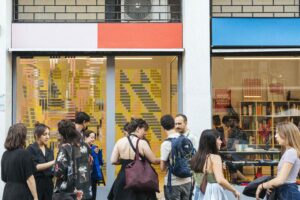
Team Thursday, Sungazing, installation view at Parco Studio, courtesy the Parco Studio
How do you develop a graphic design exhibition?
We invite designers and design studios whose work we admire. The first contact is made by email and – except for a few specific cases – these are professionals with whom we have never spoken before. The thing that surprises us each time is the enthusiasm with which the proposal is received. From there the confrontation, almost always at a distance, between us and the designers involved begins. We try to let them as much free as possible from a formal point of view, trusting that the portfolio of those invited is a sufficient guarantee of the final quality of the project. We are two designers who at some point decided to try curating graphic exhibitions, and this inevitably influences the development of shows in our space a lot. In the exchanges with the designers we invite, we unavoidably end up playing different roles: commissioners, curators, and designers. We strongly believe in collaboration and believe that the best results come from confrontation, from discussing each other’s positions, but this type of approach requires a certain availability and openness on the part of all parties involved. It is no coincidence that the exhibitions we were most satisfied with were also the most fun, made together with those who decided to completely adhere to the Parco Gallery project. When it comes time for the set-up, always very close to the opening date, it is the first time we see each other in person, and even if we have only spoken a few times, on a call or by email, it feels like we have known each other for much longer.
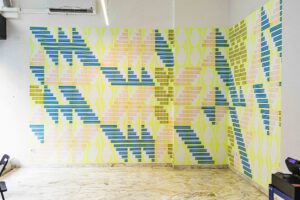
Team Thursday, Sungazing, installation view at Parco Studio, courtesy the Parco Studio
Your exhibition programme includes both Italian graphic designers and international groups. What criteria are used to select the different guests? Is there a common thematic line?
As we mentioned above, the original intention of Parco Gallery was to look abroad as much as possible, then 2020 inevitably changed our plans, and while on the one hand, it made it more difficult to collaborate with foreign countries, on the other hand, it awakened in us the necessity to dialogue more with the Italian and local scene. There is no common thematic line, or at least not a conscious one. Looking back at the production of these first five years, the trait that is certainly shared is the possibility to experiment and try outside of a commission, freedom! At the same time, we try to ensure that each show can be an opportunity to reflect on the role of the graphic designer in the contemporary world as well as on graphics and its relationship to human beings. How many and what forms can graphics take? How does it influence our emotions? What does it tell us about ourselves, our cities, and the society we live in? What is the boundary between contemporary and fashion? This is of great interest to us, to reflect on the present without chasing the latest trend.d.
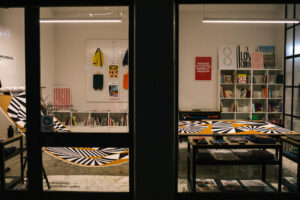
Trecentosessantamila, 2021 © Cartacarbone, courtesy the Parco Studio
Compared to other more immediate visual languages, graphics can present itself as a code that can only be understood by a restricted audience, such as professionals. What tricks do you use to interface with less experienced visitors?
We believe that everyone is used to interfacing with graphics daily: graphics is everywhere and everyone interacts with it constantly, but it still lives in the shadow of its relatives considered more noble, such as fashion, product design, or more immediately related to a common concept of art, such as photography or illustration. Putting graphics on display, however, means extrapolating it from its natural environment, and this is probably what generates a slight estrangement. We welcome visitors into our space overlooking the street and tell them the details of the projects, the research behind them, and the authors. We are not sure we can make it understandable, but at least we try to intrigue, to convey our passion, to make it fascinating, to invite you to look at it in a different way.
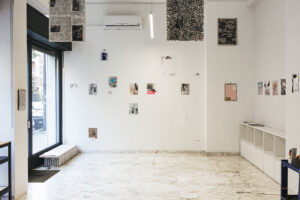
Patrick Thomas, 2022, In situ © Cartacarbone, courtesy the Parco Studio
Today there is a tendency to simplify to make complex content more accessible, however this process often equates to a reduction in language.
Let’s think for a second about the average screen time of a post while scrolling through our Instagram feed. A few seconds. In that short time, we need to be able to attract and be understood. This logic permeates every aspect of the society in which we live, we go fast, very fast, which is why the information that comes to us must be simple, immediately comprehensible, and categorised. The narrative of complexity fails, we can be one thing and one thing only. With Parco Gallery we claim the right to be complex, varied and multifaceted, to showcase the hyper-formal research of some design studios and host activist events, to display a book on cyberfeminism and a stuffed monkey on the same shelf.
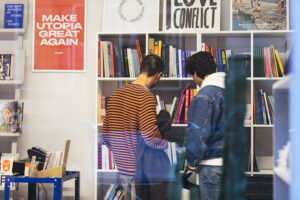
Il bookshop di Parco Gallery, 2022 © Cartacarbone, courtesy the Parco Studio
Let’s talk about Hotpot, how is it articulated and what are its aims?
Hotpot is the editorial project of Parco Gallery. Every six months an external editor publishes an essay on design theory and/or design criticism. Each essay is divided into three parts that come out in a newsletter every two months. When each new chapter is published, the previous chapter is made available on the Parco Gallery website. It is a tool for research and in-depth study, if the exhibitions and events we have hosted since 2018 often emphasise the many practices of graphic design, Hotpot allows us to retrieve their theories and histories, in the same spirit: a dialogue between the curator, the curator and their guests, open towards the Italian and international design community. Distribution via newsletters allows us to reach an audience that has deliberately chosen to subscribe and that we assume will be happy to tackle a longer, and more challenging read that we hope will be interesting and stimulating.
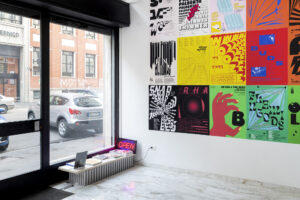
Raissa Pardini, Musica, musica, musica, 2019 © Matteo Girola, courtesy the Parco Studio
Can you give us some hints about the next issue?
We are very happy to host Vera Sacchetti, a critic, researcher and curator of Portuguese design based in Basel, for the next issue, which will be published in September. Vera is currently the programme coordinator of the multidisciplinary research initiative Driving the Human: Seven Prototypes for Eco-social Renewal, co-initiator of the Design and Democracy platform and lecturer at HEAD in Geneva. Vera’s essay does not have a title yet, but we can already say that it will be an analysis – articulated between past, present, and future – of the mechanisms of “invisibilisation” of women’s work in the creative disciplines, that it will aim to extend to all those categories that have been historically ignored in a world compromised by the supremacy of the heterosexual Western white male.
Info:
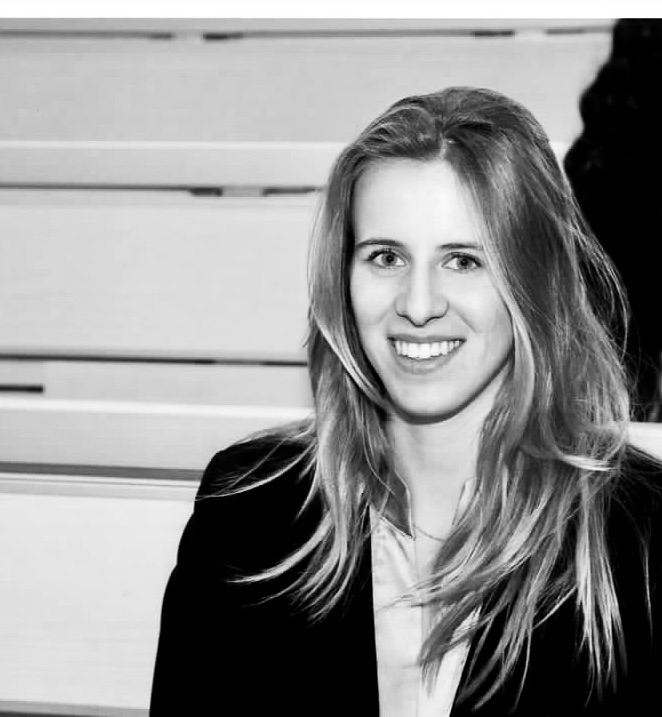
Mariavittoria Pirera, born in 1995, has a historical-artistic education obtained with a three-year degree in History of Cultural Heritage, historical-artistic profile, at Università Cattolica del Sacro Cuore, Milan, and with a master’s degree in History and Conservation of artistic heritage, contemporary art history, at Ca’ Foscari University, Venice. She lives and works in Milan.






NO COMMENT